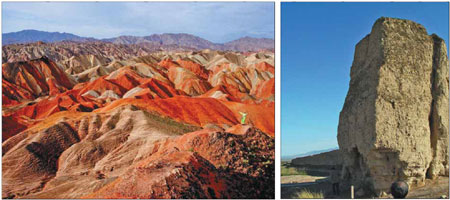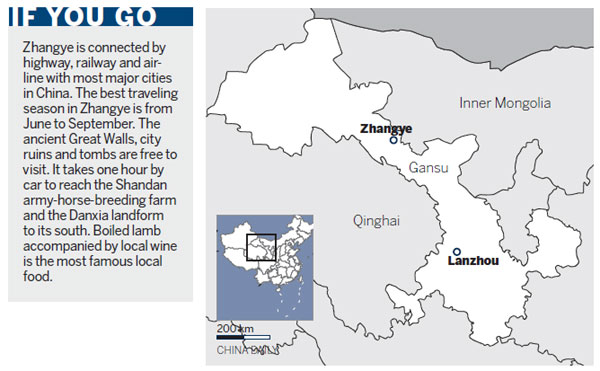Palette of life

The unique Danxia landform (left) and sections of the Great Walls built in the Han and Ming dynasties are two major attractions in Zhangye, Gansu province. [Zhao Junchao / for China Daily Qi Ta / for China Daily]
The color and shape of the land itself have defined the people who have lived in China's West for centuries. Li Yang reports from Zhangye, Gansu province.
Cities have colors. Zhangye has yellow from the Gobi desert and the ancient Great Walls; white from the snowy mountains of Qilian; green from the oasis and an army-horse-breeding farm; red from the unique Danxia landforms and golden yellow for the grain it produces and the ancient Buddhist texts written with gold powder.
The city in the middle of the Hexi Corridor was a western fortress for much of China's history before the Song Dynasty (960-1276). Its name, literally meaning to extend the arms, is an abbreviation of a saying in the Han Dynasty (206 BC-AD 220) about extending the arm of the empire to reach the Western Realm when the city was established.
Zhangye's Danxia landform, formed more than 2 million years ago, is 35 kilometers south of the city and covers an area of about 40 square km. The term Danxia landform refers to the ranges of red glutenite mountains developed through centuries of weathering and erosion by wind and water.
The peaks, in various shapes and hues, stretch along the Heihe River and its branches, between which the Zhangye oasis is perched.
North of the oasis, the mountains stretch neatly with clear ridges inclining to the same direction. To the south, the mountain ridges cross each other and peaks are of different shapes in a variety of colors, including yellow, brown, red and bronze.
The colors change with the light of a day, making the topography seem alive. The landform is said to be the prototype of the Huoyan Hill mentioned in the Chinese traditional literary classic Journey to the West.
Local landscape photographer Meng Xi says: "The best time to catch Danxia's beauty is on a sunny day, especially after a rain."
The Heihe River originates from the snow-capped Qilian Mountains in the northeast of the Hexi Corridor. It not only irrigates 240,000 hectares of fertile farmland, but also provides water to wetlands in the city. Zhangye produces about a quarter of the province's grain, with 7 percent of Gansu's farmland nurtured by the Heihe River.
The wetland is composed of lakes, moors and reed beds across 33,000 hectares in its core area. It's the largest oasis in China's Gobi desert and an important stopover site for dozens of species of migratory birds from Siberia to Central and South Asia.
Zhangye has a rich historical legacy. North of the city, thousands of ancient tombs are covered by potato fields or stretches of sand. Thousands more have already been robbed or destroyed.
It is said one 50-km section of road in Zhangye connecting Gansu and the Xinjiang Uygur autonomous region was built with the remains of ancient tombs, which were looted by the local warlord Ma Bufang to pay for his soldiers' provisions during China's civil war between 1945 and 1949.
Dafo Temple in Zhangye's urban area is famous for a clay sleeping Sakyamuni sculpture 35 meters long and 8 meters wide.
The temple, built in the Western Xia regime (1038-1277), gradually became the largest Buddhist center in the Hexi Corridor after several rounds of rebuilding. Kublai Khan, grandson of Genghis Khan and emperor of the Yuan Dynasty (1271-1368), was said to be born in the temple in 1215.
The exchange of civilizations on the Silk Road brought a treasure trove of ancient Buddhist books to the temple, most of which were destroyed during the "cultural revolution" (1966-76), including those hidden in the abdomen of the big Buddha statue.
The valuable Buddhist texts exhibited in the temple today, dating back to the Tang Dynasty (AD 618-907), were protected in the scripture library by a nun named Benjue. She secretly hid 12 boxes of valuable books in her tiny room in 1955 until her death in a fire in 1975.
To the south of Zhangye, out of the Danxia range, lies the Shandan army-horse-breeding farm of 2,200 square km. It's one of the largest of its kind in the world. The farm was built in the Han Dynasty to defend against the invading nomadic tribes and prospered until the late Qing Dynasty (1644-1911). It is now operated by a State-owned enterprise of animal husbandry for agricultural production and tourism.
North of Zhangye, two parallel Great Walls built with soil run 10 to 80 meters apart for almost 100 km at the foot of the Qilian Mountains along the Hexi Corridor. They represent one of the best-preserved Great Wall sections in China.
The outer wall was built in 111 BC in the Han Dynasty, while the inner wall was built in 1572 in the Ming Dynasty. They look magnificent against the bigger backdrop of the snow-capped Qilian Mountains.
The local government protects the walls with barbed wire to prevent shepherds from digging dwelling caves in the wall or farmers from digging into the wall for soil.
To the south are dozens of ancient city ruins deserted by armies and residents since the Han Dynasty because of water shortages. Strong weathering leaves rings of earthen city walls covered with sand - a treasure trove for explorers.
Xue Chaohua contributed to this story.









